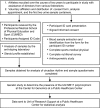Impact of UGT2B17 gene deletion on the steroid profile of an athlete
- PMID: 26668303
- PMCID: PMC4760435
- DOI: 10.14814/phy2.12645
Impact of UGT2B17 gene deletion on the steroid profile of an athlete
Abstract
The measurement of the testosterone to epitestosterone ratio (T/E ratio) in urine is often used as a marker for testosterone administration in the doping control field. This study examines the frequencies of the different expression forms of the UGT2B17 gene, and assesses their effects on this marker in volunteer subjects. The sample for this descriptive study was composed of male and female athletes aged between 16 and 55 years old who practiced different sports disciplines. All participants underwent a sports-medical physical examination, and subsequently provided 10 urine samples consecutively over a period of 48 h. The dependent variable examined was T/E and the main independent variable was the UGT2B17 gene polymorphism. During 1 year, 1410 urine samples were obtained from 141 athletes. The frequencies of the three genotypes were as follows: wt homozygotes (ins/ins) 48.2% (n = 68), mutant homozygotes (del/del) 12.1% (n = 17), and heterozygotes (ins/del) 39.7% (n = 56). Genotype distributions varied significantly (P < 0.001) according to ethnicity, 80% of Asian subjects being homozygous for the gene deletion (del/del) compared to 6.9% of Caucasian subjects. A multivariate analysis adjusted for genotype, age, sex, and sports discipline revealed that athletes with the del/del polymorphism showed a significantly lower mean T/E than heterozygotes (ins/del). In contrast, homozygous athletes for the gene insertion (ins/ins) showed higher mean T/E ratios than heterozygotes (ins/del). UGT2B17 gene deletion has a strong influence on the T/E ratio in urine, which is the most efficient indicator of testosterone prohormone misuse. Others factors studied seem not to have such an impact. The genotyping of UGT2B17 is an important source of information for understanding steroid profiling in the doping control field; therefore it is suggested that it be included in the Athletes Biological Passport.
Keywords: Exercise; UGT2B17 genotype; doping; steroid profile.
© 2015 The Authors. Physiological Reports published by Wiley Periodicals, Inc. on behalf of the American Physiological Society and The Physiological Society.
Figures
References
-
- Donike, M. , Rauth S., and Wolansky A.. 1993. Reference ranges of urinary endogenous steroids determined by gas chromatography/mass spectrometry Pp. 69–86 in Proceedings of the 10th Cologne Workshop on Dope Analysis. Sport und Buch Strauß, Cologne.
-
- Ekström, L. , Cevenini L., Michelini E., Schulze J., Thörngren J. O., Belanger A., et al. 2013. Testosterone challenge and androgen receptor activity in relation to UGT2B17 genotypes. Eur. J. Clin. Invest. 43:248–255. - PubMed
-
- Fabregat, A. , Pozo O. J., Marcos J., Segura J., and Ventura R.. 2010. Quantification of testosterone and metabolites released after alkaline treatment in human urine. Drug Test Anal. 2:630–636. - PubMed
LinkOut - more resources
Full Text Sources
Other Literature Sources



